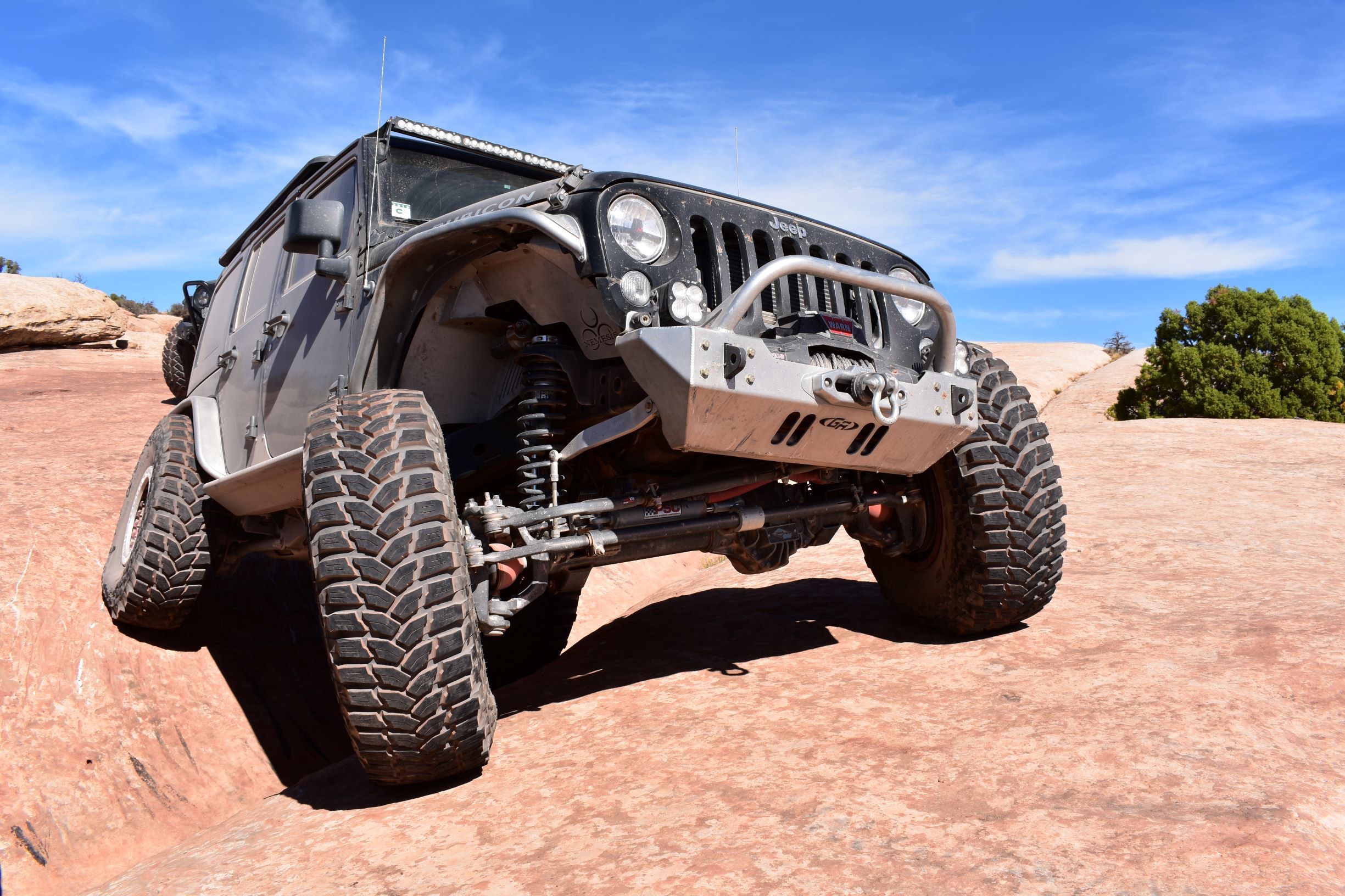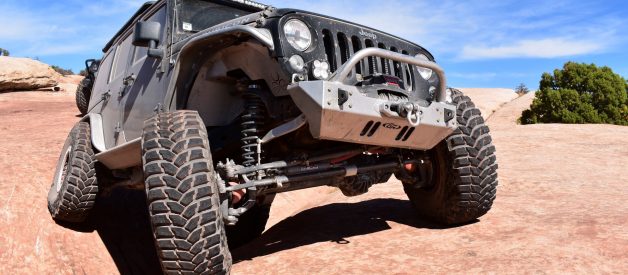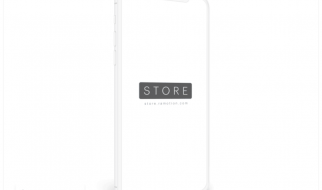
Building a Jeep Wrangler for rock crawling can seem to be a daunting task, but, the basics for building a Jeep for this type of activity really haven?t changed since Jeep reintroduced a coil spring type suspension in 1997 with the TJ/LJ lineup. Jeep?s are uniquely positioned for this type of activity because of the straight axles they employ (unlike the independent front (and in some cases rear) independent suspension.
As most know, the concept of the Jeep was introduced for World War 2 and the ?General Purpose or Jeep? vehicle was produced by a variety of manufacturers to get as many impossible into the war. The recipe proved to be extremely capable and has evolved over the years being manufactured by Jeep (acquired by Chrysler and then by Daimler) from CJ to YJ to TJ/LJ to JK and now has evolved to the JL/JT platform. Within those series there have been many trim levels, i.e.; Rubicon, Sahara, Golden Eagle, Renegade, Sport, ?. For the most part, today?s most popular trim levels are the Sport, Sahara and the topline trim is the Rubicon. There have been several special editions (Hard Rock, WIllys, ?), but they are typically just a combination of existing options.
When modifying a Jeep for rock crawling, you will mainly be interfacing with the things underneath the Jeep. In particular, the suspension and wheels and tires will be the main items with the drive-line, steering, brakes being ?upgrade opportunities?. Fenders, Rock Sliders, bumpers, a winch, body armor, Hi Lift Jack, Lockers (if not factory equipped), air compressor (for airing up and down), partial or full roll cage (in addition to what comes on your Jeep) all also represent areas for improvement.
Suspension:
For the suspension, what you will be looking to improve is mainly adding ground clearance, but by doing this, you put stress on many other components, so a chain reaction of upgrades starts when you start this part of the modification. The first step is typically to select a ?lift kit? which will start your journey to clearing the way for bigger tires, ? A word of advice here is to purchase the best quality lift kit you can afford from the start. I know people in the Jeep community that have upgraded their ?lift kit? 2?3 (or more) times in search of the ultimate solution. The lift kit, at a minimum, will consist of upper and lower control arms that will instantly lift your Jeep a prescribed amount. If you are going with a 3?+ lift kit, other components will be required to interoperate with this additional ground clearance, i.e.; shocks and coil springs for sure and more than likely, at this point you will be looking for extended brake lines, front and rear driveshafts (not truly required until around 4.5?s of lift) and steering geometry correction is a good idea at this point.
Wheels/Tires:
Jeeps have the ability to run larger tires than most 4 wheel drive vehicles with much less lift, but to get to the really big tires, 35? and above, modifications are typically required. The JL/JT series is an exception to this rule, but even then, if going off-road, the additional clearance will be welcome. It is also recommended that the smallest rim in height that you can run will give you the best off-road performance (and protection). The biggest determining factor here is typically the ability to clear the braking system. For JK and JL series Jeeps, a 17? Wheel is the norm. There are many other attributes of the wheel that need to be considered. For example, the ?Backspace? of the rim will determine how far the wheel/tire will either tuck in or stick out. For numbers sake, a factory rim will have a larger backspace number (tuck in) than most aftermarket rims (stick out). This is so a larger/wider tire can be employed without rubbing the frame or inner fender. There are also different materials for wheels, i.e.; steel or aluminum and different types of wheels. One different type of wheel is called a ?Bead-lock? wheel. This type of wheel employs some type of clamping mechanism to secure the tire to the wheel even when aired down to extreme levels. There are also many different types and sizes of tires to consider. For reference, a stock Jeep JK Rubicon comes with the equivalent of about a 33? tire from the factory and the tire is an all-terrain type tread pattern. Options for popular sizes included 35?, 37?, 39?, 40? and even bigger. These tires are typically between 10.5? to 13.5? wide and offered in All-Terrain, Mud and Rock tread patterns and each one of those has a variety of compound options which not only impact how they grip, but also how flexible the sidewall of the tire is. This is probably the area with the most choices and where you can really personalize the look and feel of your Jeep!
Steering:
Steering is impacted not only by lift, but also by the size and weight of your tire/wheel package. When lifting the Jeep, the steering geometry is changed and there are many options to correct this while also ?beefing? up the different components. Your steering system in a jeep is made up of the steering gear box, the power steering pump, your tie-rod link, your track bar, your drag link and then your Pitman arm which interfaces the drag link to the steering box. Most lift kits come with steering geometry correction brackets and there are many options for upgrading the drag link, tie rod and even things like the steering knuckles that are located at each front wheel location. There are also upgrades for things like upper and lower ball joints which will be put under extreme pressure with the additions we are discussing. Another item that will become a high wear item is the wheel hub or bearing assembly that is utilized in recent Jeep models. One other option with the steering is to employ the use of a steering stabilizer that will tighten the steering up a bit. One other option that is recommended for 37? and above size tires is call hydraulic assist which ties into your steering gear box, replaces your power steering pump and uses a hydraulic ram to assist with steering from side to side.
Brakes:
The stock brakes on Jeep Wranglers are typically adequate up to 33? and possibly even 35? tires. If going beyond that, it is recommended to employ a ?big brake kit?. These kits typically include larger rotors, calipers, better brake pads and in some cases, even require a larger brake booster and master cylinder. The stopping distance and ability to control your Jeep on an obstacle are dramatically improved and while some will see this as a nice to have, it is a highly recommended upgrade.
Drive-line:
Driveline improvements typically revolve around the axle shafts and the drive shafts and the components included in those items. Chromoly axle shafts simply replace the stock units and offer additional strength and longevity. There is another upgrade that upgrades the front shafts to CV or Constant Velocity type joints and they are a significant upgrade over the stock units. In regard to the drive shafts, the stock drive shafts are adequate up to a 2.5? lift, but over that, it is recommended to get extended length driveshafts. Both the front axle shafts and front and rear driveshafts employ Universal or U-Joints. The U-Joints are typically 1310 type, but an upgrade opportunity is to go to the 1350 series U-Joints. It is necessary to specify axle and drive shafts that have flanges that will accept the 1350 type U-Joints. A trick with U-Joints is to specify the greaseless type which does not have a grease channel built in which equates to more steel! Other upgrades include things like using Grade 8 hardware (nuts/bolts/?) and adding sleeves and gussets (or even a truss) to your axles to beef them up. A very important component of the drive-line is to ensure you have gears that are matched to your transmission type and tire size in order to allow the Jeep to always be in the right part of the power-band for both on and off-road driving. There are many charts online to help you make this critical gear selection. Lockers, or the ability to lock the differential so that both wheels are engaged, are also a key part of the drive-line. Lockers can be turned on or off typically using electricity, but optionally using air if you are so equipped.
Body Modifications:
Nothing changes the look of your Jeep like big wheels and tires, but there are many other upgrade opportunities in this regard. Bumpers are a very popular upgrade and can do things like incorporate an electric winch, improve your front and rear departure angles, provide additional clearance in general and of course, provide strength. The rear bumper will often incorporate some type of way to transport a spare tire and facilitate a way to connect a 3rd brake light. Other modifications in this realm include things like rock sliders, high clearance fenders, body armor, inner fender liners, roof racks, lighting options and of course, as many stickers as you desire! When ordering these items, the type of material is typically steel (but can be aluminum, ?) and care needs to be used to determine if the item is coming in bare steel or if it has been pre-painted/coated. If it come as bare steel, it is important that you factor the cost/effort of preparing the item for installation. Rock Sliders are critical to protect your body when navigating over the large rocks you will encounter. Body modifications can be both functional and aesthetic, but if they are more on the aesthetic side, you may gain the moniker of being a ?mall crawler?.
Building a Jeep to do some rock crawlin? can be from mild to wild and if you check the box to get a Rubicon, you will be equipped in regard to tire/wheel size, gears, axle ratio, lockers and clearance to handle some pretty serious terrain. It is also a great platform to build on as it has other functionality like an electronic front sway bar disconnect which will allow for much more articulation (manual sway bar disconnects are readily available and easily installed). Making the decision to go to 35? and above size tires starts to dictate what else has to be changed and will certainly cause more wear to consumable products like ball joints and wheel hub assemblies. In the end, your Jeep is a lifestyle choice and you will ultimately decide how far you want to take it. The key is to build it to your needs and to stay within your limits when going off road. Short of building a full blown buggy or unless you plan to trailer your Jeep, it is important that it is safe on the road as well, so choose your upgrades carefully! I plan to write some more advanced articles on each of these different areas, but hopefully, this will give you the basic vernacular and knowledge to start evaluating ugprades for your Jeep!


